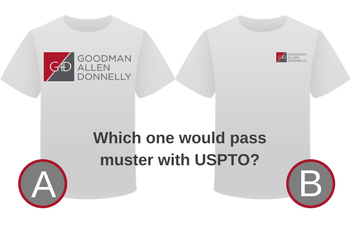Almost anything can be a trademark as long as it acts like one
by Martha A. Weis
While it is true that almost anything can be a trademark, many mark owners fail to use their marks to identify their goods or services. In such a case the United States Patent and Trademark Office (“USPTO”) will likely issue an office action refusing registration of the subject mark. One such commonly issued refusal is the so called “refusal based on ornamentation” or “ornamental refusal”.
An ornamental refusal is issued when the USPTO refuses registration of a mark because the sample of how the owner actually uses the applied-for mark (the “specimen”) is merely ornamental or a decorative feature on the goods. In other words, the mark as used on the specimen is not source identifying. For example, a slogan prominently displayed on the front of a t-shirt may be considered merely ornamental, because most purchasers of the t-shirts would not automatically think the slogan identified the source of the goods, i.e., t-shirt purveyor, but would view the slogan only as a decoration.
The USPTO typically accepts the following specimens for goods:
- A photograph of the product showing the mark directly on the product (e.g., the bottom of a coffee mug);
- Product labels and tags showing the mark (e.g., the label on a t-shirt);
- Product packaging showing the mark (e.g., detergent soap packaging);
- Signage used in a product display at a store (e.g., a photograph of the display);
- A webpage showing or describing the product near the mark and with purchasing information (e.g., a webpage showing a photograph of a computer laptop, the mark for the laptop appearing above the photograph, the price appearing below the photograph, and a shopping cart button/link appearing on the page);
- For downloadable software, copies of the instruction manual and screen printouts from (1) web pages showing the mark in connection with ordering or purchasing information or information sufficient to download the software, (2) the actual program that shows the mark in the title bar, or (3) launch screens that show the mark in an introductory message box that appears after opening the program.[i]
Using our t-shirt example, which of the two following examples do you think would pass muster with the USPTO?

Did you guess “B”? If so, you are correct. Why? Well according to the USPTO’s webpage a “small, neat, and discrete wording/design located on the pocket or breast portion of a garment (for example, the small design displayed above) may create the commercial impression of a trademark, whereas a larger depiction of the same wording/design prominently displayed across the front of a garment may be more likely to be seen as a purely decorative or ornamental feature of the goods.”[ii] Therefore, when designing your t-shirts or mugs, remember that the size, location, dominance, and significance of your mark is important.
[i] See https://www.uspto.gov/trademark/laws-regulations/specimen-refusal-how-overcome-refusal-1
[ii] See https://www.uspto.gov/trademark/laws-regulations/ornamental-refusal-and-how-overcome-refusal-0
This blog is made available by Goodman Allen Donnelly for general information, and does not constitute legal advice. By reading this blog, you understand that there is no attorney-client relationship between you and the firm. This blog should not be used as a substitute for competent legal advice from a licensed professional attorney in your state.
